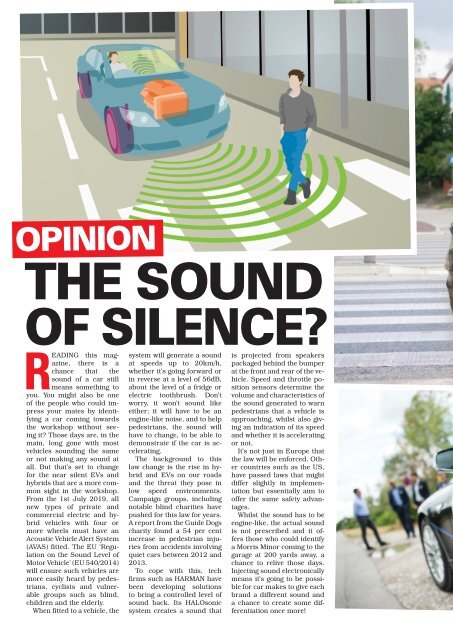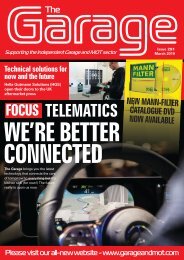You also want an ePaper? Increase the reach of your titles
YUMPU automatically turns print PDFs into web optimized ePapers that Google loves.
opinion 18<br />
Opinion<br />
<strong>The</strong> sound<br />
of silence?<br />
Reading this magazine,<br />
there is a<br />
chance that the<br />
sound of a car still<br />
means something to<br />
you. You might also be one<br />
of the people who could impress<br />
your mates by identifying<br />
a car coming towards<br />
the workshop without seeing<br />
it? Those days are, in the<br />
main, long gone with most<br />
vehicles sounding the same<br />
or not making any sound at<br />
all. But that’s set to change<br />
for the near silent EVs and<br />
hybrids that are a more common<br />
sight in the workshop.<br />
From the 1st July 2019, all<br />
new types of private and<br />
commercial electric and hybrid<br />
vehicles with four or<br />
more wheels must have an<br />
Acoustic Vehicle Alert System<br />
(AVAS) fitted. <strong>The</strong> EU ‘Regulation<br />
on the Sound Level of<br />
Motor Vehicle’ (EU 540/2014)<br />
will ensure such vehicles are<br />
more easily heard by pedestrians,<br />
cyclists and vulnerable<br />
groups such as blind,<br />
children and the elderly.<br />
When fitted to a vehicle, the<br />
system will generate a sound<br />
at speeds up to 20km/h,<br />
whether it’s going forward or<br />
in reverse at a level of 56dB,<br />
about the level of a fridge or<br />
electric toothbrush. Don’t<br />
worry, it won’t sound like<br />
either; it will have to be an<br />
engine-like noise, and to help<br />
pedestrians, the sound will<br />
have to change, to be able to<br />
demonstrate if the car is accelerating.<br />
<strong>The</strong> background to this<br />
law change is the rise in hybrid<br />
and EVs on our roads<br />
and the threat they pose in<br />
low speed environments.<br />
Campaign groups, including<br />
notable blind charities have<br />
pushed for this law for years.<br />
A report from the Guide Dogs<br />
charity found a 54 per cent<br />
increase in pedestrian injuries<br />
from accidents involving<br />
quiet cars between 2012 and<br />
2013.<br />
To cope with this, tech<br />
firms such as HARMAN have<br />
been developing solutions<br />
to bring a controlled level of<br />
sound back. Its HALOsonic<br />
system creates a sound that<br />
is projected from speakers<br />
packaged behind the bumper<br />
at the front and rear of the vehicle.<br />
Speed and throttle position<br />
sensors determine the<br />
volume and characteristics of<br />
the sound generated to warn<br />
pedestrians that a vehicle is<br />
approaching, whilst also giving<br />
an indication of its speed<br />
and whether it is accelerating<br />
or not.<br />
It’s not just in Europe that<br />
the law will be enforced. Other<br />
countries such as the US,<br />
have passed laws that might<br />
differ slightly in implementation<br />
but essentially aim to<br />
offer the same safety advantages.<br />
Whilst the sound has to be<br />
engine-like, the actual sound<br />
is not prescribed and it offers<br />
those who could identify<br />
a Morris Minor coming to the<br />
garage at 200 yards away, a<br />
chance to relive those days.<br />
Injecting sound electronically<br />
means it’s going to be possible<br />
for car makes to give each<br />
brand a different sound and<br />
a chance to create some differentiation<br />
once more!<br />
18, 19 Opinion.indd 1 04/06/2019 09:46
















